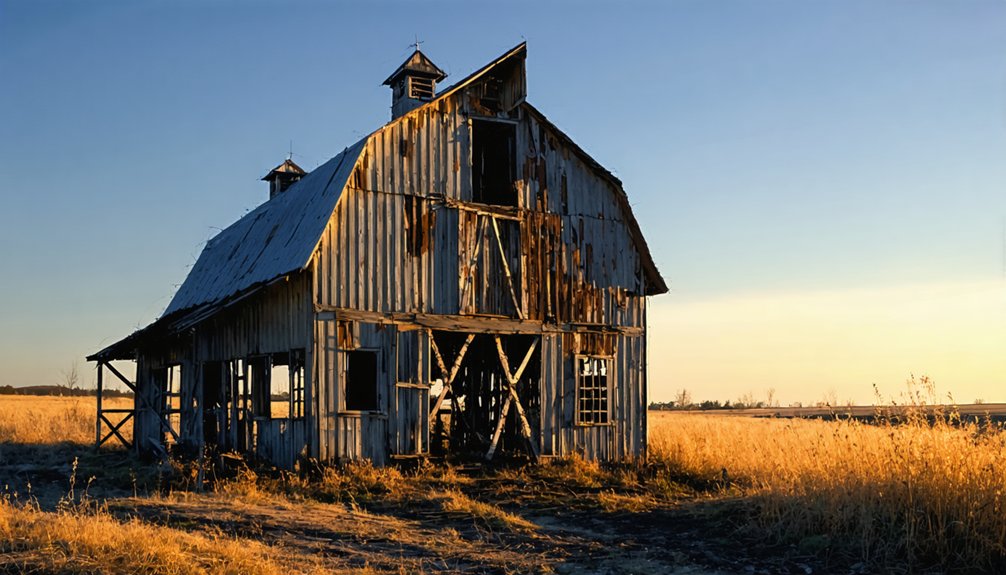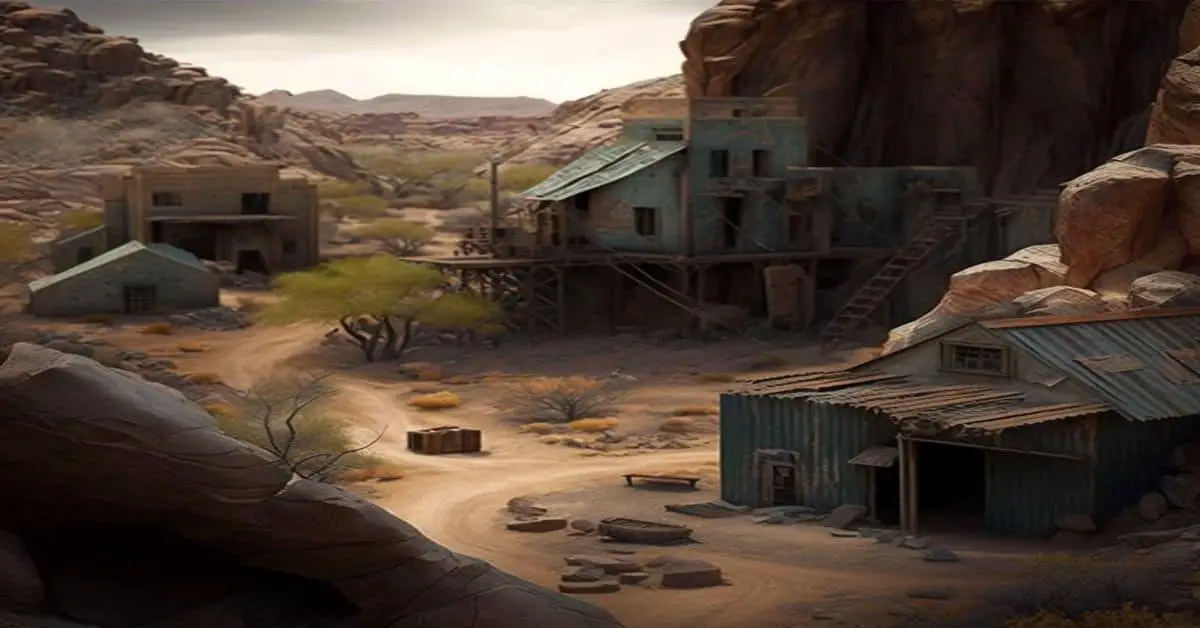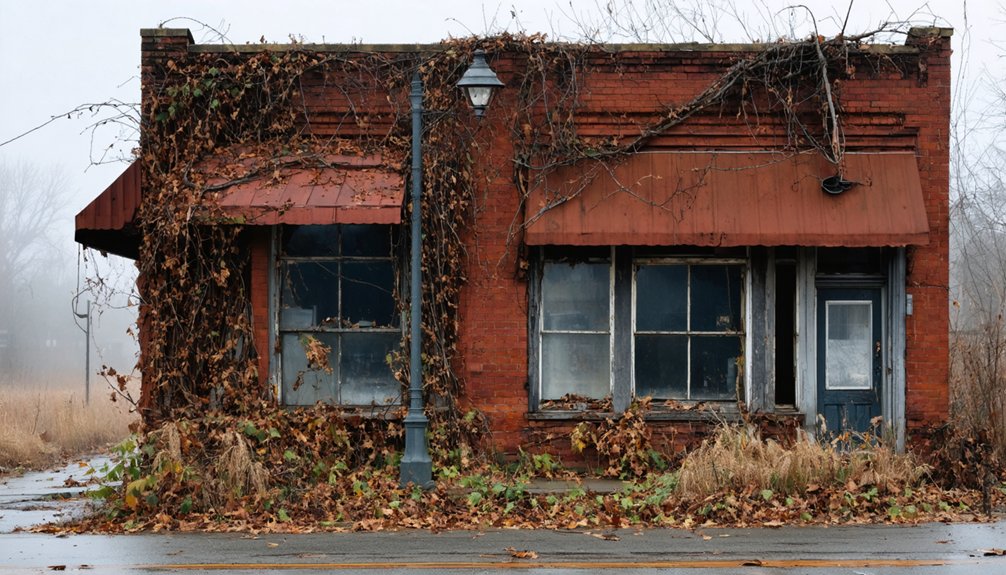You’ll find Conrad’s ghost town remnants two miles south of Lake Village, Indiana, where Jennie and George Conrad established a thriving railroad community in 1885 on 4,400 acres. The town boasted a post office, general store, hotel, and Mission Church, becoming a major livestock shipping hub. Though fires and economic challenges led to its decline by the 1970s, today the Conrad Station Savanna preserves 342 acres of natural habitat where fascinating stories of this once-bustling community await.
Key Takeaways
- Conrad, Indiana was established in 1885 by Jennie and George Conrad, spanning 7,000 acres with a post office, general store, and railroad stop.
- The town thrived as a livestock shipping hub with specialized rail facilities, serving the Chicago, Indiana, and Southern Railroad.
- Key structures included a cement block general store, blacksmith shop, hotel, brick schoolhouse, and Mission Church for multiple denominations.
- The town declined after Jennie Conrad’s death in 1939, with a devastating fire accelerating its abandonment by the mid-1970s.
- The former town site is now Conrad Station Savanna, a 342-acre Nature Conservancy preserve featuring black oak sand savanna.
The Vision of Jennie and George Conrad
Pioneers Jennie and George Conrad laid the foundation for their ambitious vision in 1885 when they purchased 4,400 acres of meadow land from Jennie’s father for a symbolic dollar. They established their ranch headquarters at “Oak Dene,” where they’d oversee their growing estate.
After George’s death in 1896, Jennie expanded their holdings to 7,000 acres by 1904, following her father’s wisdom to continuously acquire land. The town featured several community structures, including a park and boarding house. Being protective of her property, she often patrolled with shotgun to ward off trespassers.
Jennie carried on her father’s legacy, growing the ranch to 7,000 acres in the years following her husband’s death.
Jennie’s ambitions centered on creating a thriving village named Conrad that would surpass nearby Lake Village. You’ll find Conrad’s legacy in the town she built, complete with a post office, general store, and strategic railroad stop.
She convinced the Chicago and Western Indiana Railroad to make Conrad a passenger stop, capitalizing on her successful livestock shipping business that moved thousands of animals yearly.
From Beaver Lake to Bustling Settlement
Before Conrad could emerge as a bustling settlement, the dramatic transformation of Beaver Lake set the stage for pioneering development in the region. The massive drainage project opened up thousands of acres for agricultural expansion, with Lemuel Milk alone acquiring 12,000 acres of newly available land. Much like City West’s decline, Conrad’s promising development would eventually succumb to economic challenges. Jenny Conrad’s inheritance of land from her father in 1895 for one dollar marked the beginning of the town’s establishment.
You’ll find these key developments shaped Conrad’s early years:
- The land’s transformation from lake to meadow created prime conditions for farming and livestock operations.
- Strategic location two miles south of Lake Village positioned Conrad for growth.
- The Chicago and Western Indiana Railroad provided crucial transportation links.
- Essential infrastructure emerged, including a post office, general store, school, and hotel.
This remarkable transformation laid the foundation for Conrad’s brief but significant role in Indiana’s agricultural heritage.
Railroad Glory Days and Livestock Operations
When you examine Conrad’s peak years, you’ll find the railroad played a pivotal role in transforming this small town into a thriving livestock shipping hub.
The extensive railroad infrastructure, complete with specialized livestock cars and long unloading tracks, enabled local farmers to transport their cattle and other livestock to major markets efficiently. The area’s pork packing industry processed over 63,000 hogs by the mid-1840s, marking significant economic growth.
Jennie Conrad’s profitable livestock operation exemplified the economic success that railroad access brought to the community, as she focused on improved breeding programs and modern feeding systems that capitalized on the reliable transportation network. The rail yard incorporated innovative live poultry cars that revolutionized the transport of turkeys and other birds with features like mesh netting for ventilation and self-cleaning cages.
Railroad Shipping Operations
As the Chicago, Indiana, and Southern Railroad established its presence in Conrad, the town quickly emerged as an essential shipping hub, particularly for livestock operations.
You’d find the impressive stone depot serving as the nerve center for shipping activities, distinguishing Conrad from other stops along the line. Railroad workers maintained detailed operating reports to track the movement of goods through the station, similar to those preserved in the Central Indiana Railway Company collection.
The railroad impact on Conrad’s commerce was substantial, with specialized facilities designed for maximum efficiency:
- The stockyards could accommodate up to 5,000 cattle at once
- Direct rail sidings connected both the stockyard and cement block factory
- Local farmers saved significant travel time by shipping from Conrad instead of Roselawn
- The cement block plant exported products nationwide, even reaching New York City
Much like the Indiana Harbor Belt Railroad’s operations, which included maintaining icing facilities at yards for refrigerated shipments, Conrad’s depot featured modern cooling systems for perishable goods. After Jennie Conrad’s death in 1939, the livestock decline began, marking the beginning of the end for this once-bustling shipping center.
Livestock Economic Impact
Under Jennie Conrad’s strategic vision, livestock operations transformed Conrad into a thriving agricultural powerhouse by 1904, with expansive holdings of 7,000 acres dedicated to cattle, hogs, and horses.
Her livestock sustainability practices included utilizing natural forage, with hogs fattening on bluegrass and acorns in oak woodlands during autumn months. Just as Ellen the Holstein achieved world record milk production in 1975, Conrad’s innovative agricultural practices revolutionized local farming operations. Similar to other towns that emerged during Indiana’s post-Civil War industrial growth, Conrad’s success was tied to agricultural advancement.
The farm’s economic diversification strategies centered on creating a robust shipping hub for livestock and produce.
You’d find extensive stockyards, holding pens, and a busy depot serving high-profile clients from Chicago.
This infrastructure spurred local development, including a boarding house and general store to support workers and traders.
The volume of livestock shipped was significant enough to influence railroad schedules, cementing Conrad’s position as an essential agricultural market center.
Town Life and Key Buildings
Despite its small size, Conrad boasted several key buildings that formed the backbone of daily life in this Indiana town.
Local ghost stories often center around the imposing two-story frame building with 18 rooms, while town folklore frequently mentions Jennie M. Conrad’s contentious relationships with neighbors.
You’ll find these vital structures defined the community’s character:
- A cement block building housed both the post office with 30 mailboxes and the general store.
- The blacksmith shop, operated by Adam Press, provided essential metalworking services.
- A hotel near the railroad tracks served travelers, with its foundation ruins still visible today.
- The brick schoolhouse, built in 1927, represented progress until its materials were repurposed for Lake Village Elementary.
The Mission Church and Community Spirit

You’ll find the Mission Church’s history began on August 14, 1908, when Presbyterian lots were deeded for a unique ecumenical experiment in Conrad.
The church’s weekly services adapted to serve multiple denominations, with ministers adjusting their sermons based on the majority faith present that week, whether Baptist, Episcopal, or Catholic.
This flexible approach to worship helped maintain community bonds during Conrad’s active years, as the church served as both a spiritual center and social hub for the town’s diverse religious population.
Ecumenical Foundations and Growth
While many rural churches aligned with specific denominations, Conrad’s Mission Church embodied a unique ecumenical spirit from its Presbyterian roots.
You’ll find its story reflects remarkable community resilience, as the congregation adapted weekly services to accommodate different faith traditions.
- The church’s formal establishment in 1908 created a flexible worship space where Presbyterian, Baptist, Episcopal, and Catholic members could gather freely.
- Services rotated between denominations based on weekly attendance, with visiting clergy leading worship.
- Catholic priests occasionally served the congregation, demonstrating true ecumenical harmony.
- The democratic approach to leadership allowed the church to serve Conrad’s diverse religious needs while maintaining unity.
The two-story cement block building, which also housed the post office and store, became a symbol of the community’s commitment to inclusive worship and shared space.
Multi-Faith Worship Services
As Conrad’s Mission Church grew, its innovative approach to multi-faith worship set a remarkable precedent for rural religious gatherings.
You’d find services adapting weekly based on the predominant denomination present, with ministers readily accommodating Presbyterians, Catholics, Baptists, and Episcopalians through a democratic “head count” system.
This flexible arrangement fostered spiritual unity among Conrad’s residents, transcending traditional denominational boundaries. The church’s practical approach meant you could witness a Presbyterian service one week and a Catholic mass the next, creating a unique shared religious experience.
This adaptability proved essential for community resilience, especially as Conrad’s population declined. Without permanent clergy, visiting ministers from various faiths sustained the congregation, demonstrating how rural communities could maintain vibrant religious life despite limited resources.
Building’s Legacy Until Today
The Mission Church stands as one of Conrad’s last physical reminders of its once-thriving community spirit. The Presbyterian building, deeded in 1908, represents Conrad’s architecture at its peak, when the town’s future seemed bright under Jennie M. Conrad’s leadership.
You’ll find evidence of community resilience in the way residents adapted the church for multi-denominational worship, making it a cornerstone of local life.
- The church served alongside other key structures like the two-story cement block building housing the post office and general store.
- These buildings formed the town’s social nucleus until its decline after 1939.
- While most structures have been abandoned, they tell the story of Conrad’s rise and fall.
- The remaining buildings stand as silent witnesses to the town’s transformation from a bustling railway stop to a ghost town.
Economic Struggles and Town Dissolution
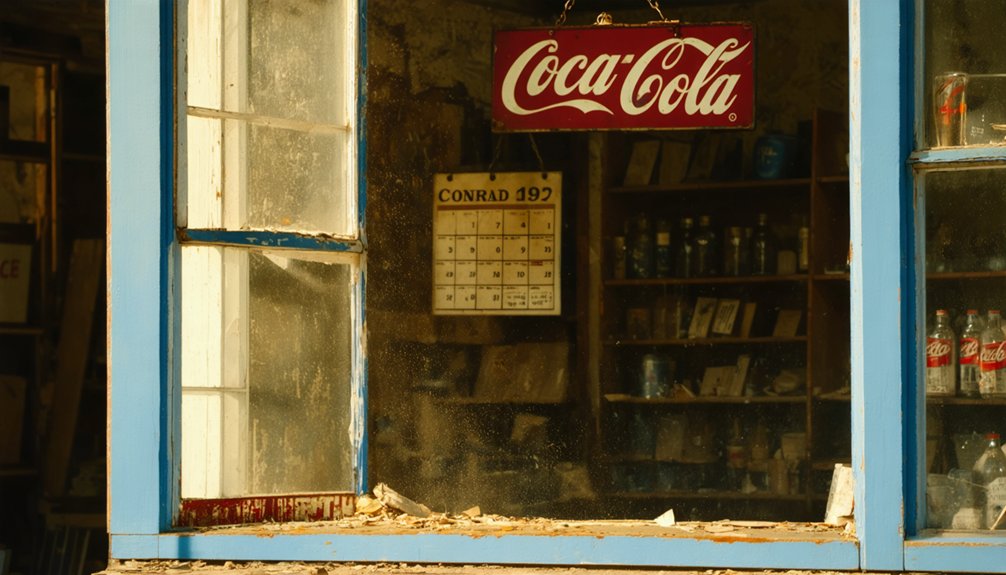
Despite Jennie Conrad’s entrepreneurial vision and the town’s early economic promise, Conrad faced mounting challenges that ultimately led to its dissolution.
You’ll find that external competition from nearby Lake Village and neighborhood disputes undermined the town’s economic resilience. The community’s hardships intensified after an arsonist destroyed a 40-acre wheat field, dealing a severe blow to agricultural productivity.
The town’s limited infrastructure and heavy reliance on agriculture left little room for community adaptation when changes were needed. After Jennie Conrad’s death in 1939, leadership passed to her son Platt, but the town’s liveliness waned.
A devastating fire accelerated the decline, and by the mid-1970s, Conrad had largely emptied, leaving only remnants of its once-bustling infrastructure.
Natural Transformation and Present Landscape
Following the town’s dissolution, a remarkable ecological transformation took shape when The Nature Conservancy purchased 300 acres of Conrad’s former grounds in the late 1990s.
Today, you’ll find a thriving black oak sand savanna where the town once stood, maintained through natural preservation efforts that include controlled burns and careful habitat management.
The site’s ecological balance supports diverse wildlife and native plants while preserving remnants of Conrad’s history.
You’ll discover:
- A two-mile interpretive trail showcasing both natural wonders and cultural heritage
- Rolling sand dunes dotted with drought-resistant oak trees
- Native prairie grasses including Junegrass and bluestem varieties
- Abundant wildlife such as red-headed woodpeckers and glass lizards
This transformed landscape now connects with other essential conservation areas, creating a network of protected habitats in northwest Indiana.
Tales and Legends of Abandoned Conrad
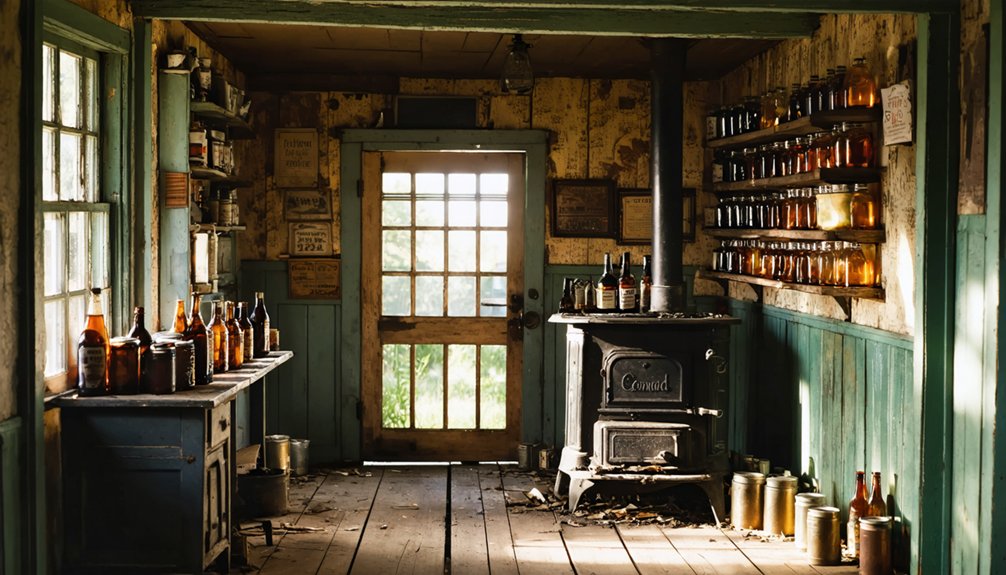
Local tales suggest that Conrad’s abandoned grounds harbor more than just historical remnants, as both longtime residents and curious visitors have reported unexplained phenomena throughout the years.
You’ll find stories of ghostly encounters centered around a mysterious phantom train that’s said to claim lives along the old railroad tracks. These local folklore elements have transformed Conrad into a destination for ghost tours exploring Indiana’s supernatural heritage.
Ghost stories of a deadly phantom train have made Conrad’s abandoned tracks a magnet for supernatural tourism in Indiana.
Witnesses have reported inexplicable sightings of blood appearing on nearby roads, adding to the town’s mystique.
While these tales might seem far-fetched, they’ve become deeply woven into the fabric of Conrad’s legacy, drawing curious visitors who seek to experience both the historical significance and potential paranormal activity at this once-thriving railroad town.
Preservation and Historical Significance
Beyond the ghostly tales that draw visitors to Conrad, serious preservation work continues to protect both the natural and historical legacy of this vanished Indiana town.
Despite preservation challenges like material repurposing and site degradation, you’ll find dedicated community engagement through local historical societies and The Nature Conservancy’s management of Conrad Station Savanna.
- You can explore the Conrad Trail and bridge, which serve as living classrooms for both natural and historical education.
- You’ll discover archived photographs and records at Lowell Public Library documenting the town’s rich past.
- You can witness the adaptive reuse of quality materials, like the school’s bricks, in surrounding communities.
- You’ll find evidence of Conrad’s agricultural heritage through preserved records of its livestock operations and commerce.
Exploring Conrad’s Remnants Today
You’ll find scattered foundations and remnants of Conrad’s former structures, including what’s believed to be the hotel and depot, hidden beneath layers of native vegetation and underbrush.
A two-mile interpretive trail guides you through the ghost town’s footprint, where historical markers help piece together the community’s past alongside rolling sand dunes and restored prairie.
The Nature Conservancy’s management has transformed this once-bustling town into a unique blend of cultural heritage and natural habitat, where you can observe both architectural traces and thriving wildlife like red-headed woodpeckers and glass lizards.
Physical Traces Remain Today
While Conrad, Indiana no longer exists as a thriving town, visitors can still find significant physical traces scattered across the 342-acre Conrad Station Savanna.
You’ll discover foundational remnants of major structures amid the black oak savanna, including the church’s partial basement, post office’s concrete foundation, and hotel’s historical marker near the trail.
- The church site reveals Presbyterian origins from 1908, with foundations marking where multiple denominations once worshipped.
- A large 75′ x 45′ foundation shows where the two-story cement block post office stood.
- High-quality bricks and steps along the trails hint at the former school’s location.
- Historical markers and interpretive trails guide you through these historical artifacts, connecting you to Conrad’s past while you explore the natural landscape.
Nature Reclaims Town Sites
As nature steadily reclaims the former town site of Conrad, native vegetation and wildlife have transformed the landscape into a thriving ecological community.
You’ll find black oak sand savanna, a rare habitat type, flourishing where buildings once stood. The vegetation restoration includes seasonal wildflowers, native grasses, and trees that have overtaken old foundations and pathways.
Wildlife resurgence is evident as deer, birds, and small mammals now inhabit the area, supported by emerging seasonal wetlands and the site’s connection to Kankakee Sands.
You can explore these changes via nature trails, where interpretive signs reveal how the town’s structural remains slowly merge with the surrounding ecosystem.
The area’s gradual evolution from abandoned settlement to natural habitat showcases nature’s remarkable ability to heal and restore itself.
Historical Markers and Trails
Today’s visitors can explore Conrad’s historical remnants through a network of well-marked trails that wind through the Conrad Station Savanna.
Your ghost town exploration will reveal fascinating traces of this once-bustling community, where interpretive signs help you understand the historical significance of each location.
- You’ll discover clear foundations marking major structures, including the Presbyterian church and two-story post office.
- You can identify the old depot site near the railroad tracks.
- You’ll find the historic school steps along the hiking path, remnants of the 1927 brick schoolhouse.
- You can trace the town’s layout through visible street patterns and building sites.
The Nature Conservancy protects these remnants, ensuring future generations can connect with Conrad’s rich heritage.
Frequently Asked Questions
What Happened to the Town’s Records and Historical Documents After Abandonment?
Like autumn leaves scattered by time, you’ll find no preserved town records exist – they vanished with Conrad’s decline, their historical significance lost when no institutions collected or archived the documents.
Were There Any Notable Crimes or Incidents in Conrad During Its Existence?
You’ll find few documented crimes beyond the burning of Jennie Conrad’s wheat field by angry boys. While local lore hints at mysterious disappearances and unsolved cases, there’s no official evidence supporting these claims.
How Many People Lived in Conrad at Its Peak Population?
You’ll find that during the height of settlement, when population trends were still positive and before ghost stories emerged, approximately 40 free spirits called this place home, supporting roughly 12 modest dwellings.
Did Any Famous People Ever Visit or Stay in Conrad?
You won’t find any documented historical visitors or celebrity sightings in Conrad. Records and local histories don’t mention any famous people visiting the small town during its brief existence.
What Happened to the Residents Who Left Conrad After Its Decline?
You’ll find most residents relocated to nearby towns like Rensselaer and Lake Village. Local records show migration patterns followed economic factors, as former Conrad citizens sought fresh opportunities where businesses and services remained viable.
References
- https://www.youtube.com/watch?v=S2SHWHKyOmI
- https://www.lowellpl.lib.in.us/lowell-history-pages/the-ghost-town-of-northwest-indiana/
- https://www.lowellpl.lib.in.us/s1990jun.htm
- https://rensselaeradventures.blogspot.com/2009/12/newton-county-ghost-town.html
- https://www.youtube.com/watch?v=iWoZ22wahio
- https://www.nature.org/en-us/get-involved/how-to-help/places-we-protect/conrad-station-savanna/
- https://en.wikipedia.org/wiki/List_of_ghost_towns_in_Indiana
- http://ingenweb.org/innewton/Images/Land Mark Pamphlet Final.pdf
- https://graveyards.com/IL/Kankakee/moundgrove/conrad.html
- http://ingenweb.org/innewton/countyhistory/History of Lake Village (Mar. 25
